Activation-dependent properties of pregnenolone sulfate inhibition of GABAA receptor-mediated current
- PMID: 12938673
- PMCID: PMC2343070
- DOI: 10.1113/jphysiol.2003.043810
Activation-dependent properties of pregnenolone sulfate inhibition of GABAA receptor-mediated current
Abstract
Sulfated steroids like pregnenolone sulfate (PS) are found endogenously in the central nervous system where they may modulate GABAA receptors. Understanding the mechanism of steroid inhibition is important for understanding the conditions under which endogenous steroids modulate GABAA receptor function, assessing their potential clinical utility, and for evaluating sulfated steroids as probes of receptor behaviour. Some previous studies suggest that sulfated steroid inhibition exhibits activation dependence, whilst other studies suggest only slow, time-dependent inhibition, perhaps reflecting slow PS association with receptors. We tested activation dependence in several ways. Steroid potency increased 2- to 3-fold with approximately 10-fold change in GABA concentration. PS inhibition of saturating partial agonist responses suggested that the level of channel activation, rather than receptor occupancy by agonist, is important for PS inhibition. Inhibition by sulfated steroids exhibited weak or no voltage dependence. Responses to rapid applications of exogenous GABA differed little whether PS was pre-applied or simply co-applied with GABA, consistent with the hypothesis that the actions of PS are facilitated by receptor activation. PS applied during steady-state GABA responses exhibited slow onset and offset rate constants. The offset, rather than onset, was significantly slowed by elevated GABA concentration. At hippocampal synapses, large, multiquantal IPSCs were inhibited more effectively by a fixed concentration of PS than small quantal content IPSCs, consistent with known 'pooling' of transmitter following multiquantal release. Picrotoxinin, although superficially similar to PS in its activation dependence, was dissimilar from PS in a number of details. In summary, PS inhibition exhibits activation dependence that may be explained by activation-dependent binding and altered desensitization.
Figures
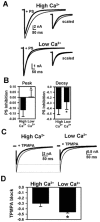
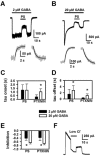



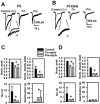
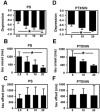

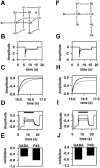
Similar articles
-
Neurosteroids 3beta, 20 (R/S)-pregnandiols decrease offset rate of the GABA-site activation at the recombinant GABA A receptor.Eur J Pharmacol. 2008 May 31;586(1-3):67-73. doi: 10.1016/j.ejphar.2008.02.063. Epub 2008 Feb 29. Eur J Pharmacol. 2008. PMID: 18374329
-
3Beta-hydroxysteroids and pregnenolone sulfate inhibit recombinant rat GABA(A) receptor through different channel property.Eur J Pharmacol. 2007 Feb 28;557(2-3):124-31. doi: 10.1016/j.ejphar.2006.11.071. Epub 2006 Dec 12. Eur J Pharmacol. 2007. PMID: 17239367
-
Pregnenolone sulfate and dehydroepiandrosterone sulfate inhibit GABA-gated chloride currents in Xenopus oocytes expressing picrotoxin-insensitive GABA(A) receptors.Neuropharmacology. 1999 Feb;38(2):267-71. doi: 10.1016/s0028-3908(98)00172-5. Neuropharmacology. 1999. PMID: 10218867
-
Pregnenolone sulfate: from steroid metabolite to TRP channel ligand.Molecules. 2013 Sep 27;18(10):12012-28. doi: 10.3390/molecules181012012. Molecules. 2013. PMID: 24084011 Free PMC article. Review.
-
Pregneolone--from Selye to Alzheimer and a model of the pregnenolone sulfate binding site on the GABAA receptor.Biochem Pharmacol. 1995 Jan 6;49(1):1-16. doi: 10.1016/0006-2952(94)00258-n. Biochem Pharmacol. 1995. PMID: 7840775 Review. No abstract available.
Cited by
-
Is connexin36 critical for GABAergic hypersynchronization in the hippocampus?J Physiol. 2011 Apr 1;589(Pt 7):1663-80. doi: 10.1113/jphysiol.2010.201491. Epub 2011 Feb 7. J Physiol. 2011. PMID: 21300748 Free PMC article.
-
Divergent mechanisms of steroid inhibition in the human ρ1 GABAA receptor.Nat Commun. 2024 Sep 6;15(1):7795. doi: 10.1038/s41467-024-51904-7. Nat Commun. 2024. PMID: 39242530 Free PMC article.
-
Neurosteroids and GABA-A Receptor Function.Front Endocrinol (Lausanne). 2011 Oct 4;2:44. doi: 10.3389/fendo.2011.00044. eCollection 2011. Front Endocrinol (Lausanne). 2011. PMID: 22654809 Free PMC article.
-
A Clickable Oxysterol Photolabel Retains NMDA Receptor Activity and Accumulates in Neurons.Front Neurosci. 2018 Dec 6;12:923. doi: 10.3389/fnins.2018.00923. eCollection 2018. Front Neurosci. 2018. PMID: 30574068 Free PMC article.
-
Characteristics of concatemeric GABA(A) receptors containing α4/δ subunits expressed in Xenopus oocytes.Br J Pharmacol. 2012 Apr;165(7):2228-43. doi: 10.1111/j.1476-5381.2011.01690.x. Br J Pharmacol. 2012. PMID: 21950777 Free PMC article.
References
Publication types
MeSH terms
Substances
Grants and funding
LinkOut - more resources
Full Text Sources

